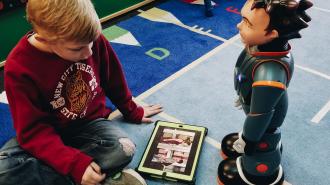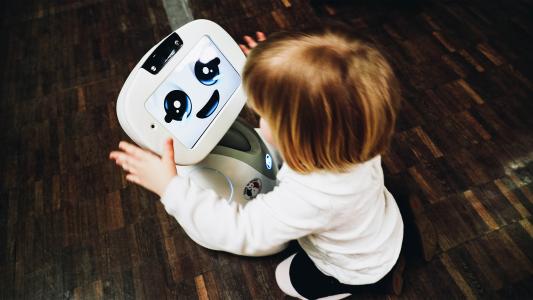When Jamie Ptacek first locked eyes with her student Isaiah, she was floored. At five years old, Isaiah hadn’t yet spoken to Ptacek, let alone looked her in the eye. That’s because Isaiah is autistic. Socialization skills are a common challenge for children with autism. Eye contact, especially, can be uncomfortable.
But Isaiah’s new friend, Milo the robot, a unique classroom assistant, had the right — um, personality — to draw Isaiah from his shell.
Employing Robots for Autism Education
Learning to understand the nuance of human emotion from a machine seems nonsensical. But, according to RoboKind’s Jeff Goodman, Milo’s creator, using robots for autism therapy makes sense because they aren’t human. They never make a mistake, change their appearance, or get tired.
Children with autism thrive on consistency and structure. Teachers arriving in the classroom with a new hairdo or an unusual energy level can be disturbing. Even a different odor can faze a child with autism. But robots like Milo are the same, day after day.
“He is so motivating and so non-threatening that kids are willing to interact with him when they’re not with their teachers. He is looked at as safe,” says Ptacek, a speech pathologist, adding that Milo is a very “cool-looking guy” that the kids like.
Milo expresses nine different emotions in straightforward ways. To show happiness, he smiles. To express anger, he pumps his fist. Through role-playing and repetition, he teaches children to recognize these emotions.
Teachers can use Milo and RoboKind’s integrated curriculum to help students recognize the same feelings in humans. Ptacek says that Isaiah was once prone to tantrums. Now he has learned strategies to calm down, like counting to 10 or squeezing a squishy ball. All thanks to Milo — and its human partners, of course.
The Promise and Challenge of Using Robots for Autism Therapy
Research has shown that children respond well when using robots for autism therapy, often improving their social skills. In a study published in Science Robotics, scientists followed 12 children with autism as they worked with robots daily for a month. The scientists assessed the participant’s social skills before and after the robot-based therapy trial, looking at scores from interactive games and caregiver observations. They found increased social capabilities across the board, as participants improved in every measured area.
Over 400 Milo robots are currently used in schools around the world, primarily North America. RoboKind plans to deploy about 200 more next year. But Milo isn’t the only robotic-aid to enter the special needs classroom. QT Robot, Kaspar, and NAO are also autism therapy robots.
Still, research is slim as most studies involve anecdotal evidence from case study observations. Although the Science Robotics study found that children improve their social skills when using the robot with their in-home lessons, they failed to compare them with similar lessons, sans robot. It’s possible that the lessons alone could serve equally as well in helping children improve social skills. Even Ptacek, who was amazed by Isaiah’s considerable improvement, says that none of her other students have shown such dramatic transformations. They have all improved, but none as rapidly as Isaiah.
Child psychologist Fred Volkmar doesn’t want to get too enthusiastic. Because of the lack of rigorous empirical evidence, he isn’t convinced that robots are the key to helping children learn to decipher the subtleties of human emotion.
“Robots are fundamentally very simple. People are extremely complicated,” he says. Transferring skills learned from robots to humans could be a tall order.
But there is still something about Milo. Ptacek says he helps her unlock students’ skills.
Ptacek had never tried using a robot for autism therapy in any of her classrooms in the Green Hills school district before last year. When she brought Milo in, Isaiah was mesmerized. He went from throwing tantrums to mimicking Milo, and from being non-verbal to communicating with a speech-generating device.
“There was so much in him that we couldn’t figure out how to get to until he was willing to let us in… until we brought Milo to him,” Ptacek says. “Isaiah has so much to offer, and so much more to learn. He has a bright future.”
Ptacek recalls something that Isaiah’s parents said: they felt like they were meeting their son for the first time. Finally, Isaiah could communicate his needs and wants. His tantrums subsided. He began asking for things like books or snacks.
Still, no one, not even Isaiah’s parents, had heard him speak. Then, one day, Milo the robot blinked and asked Isaiah, “Did I close my eyes?”
“Yes,” said Isaiah, aloud.






